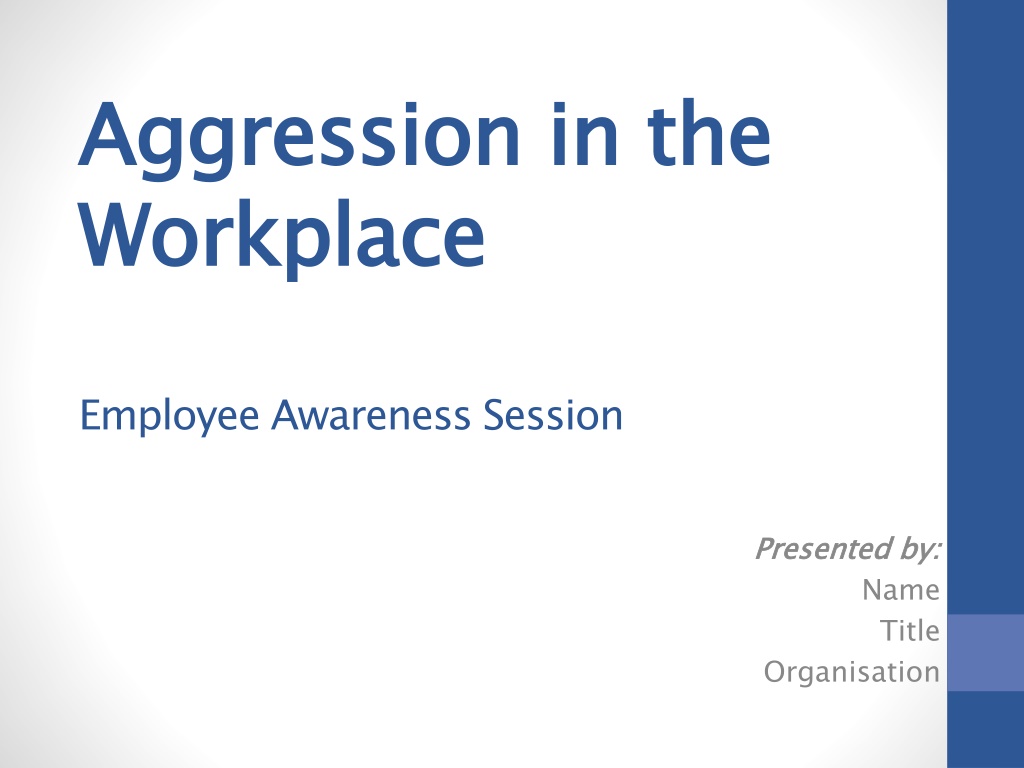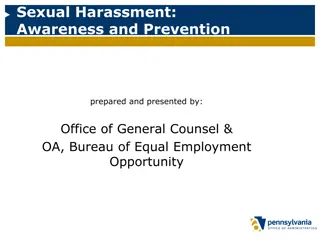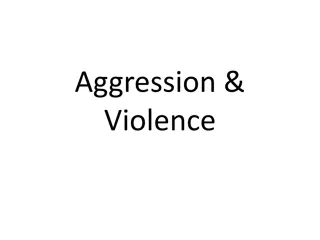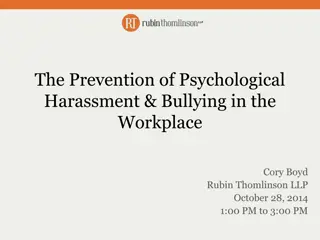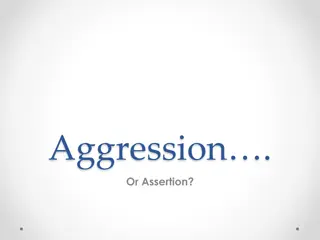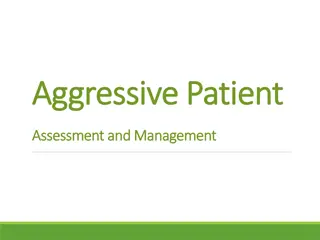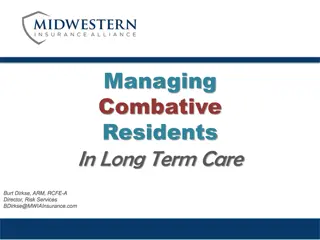Workplace Aggression Awareness Session: Understanding and Prevention
This employee awareness session sheds light on workplace aggression, its definition, effects, sources, and management. It outlines employer and employee responsibilities, current control measures, and provides training objectives to enhance awareness and prevent harm. Additionally, it emphasizes the importance of recognizing, addressing, and seeking support for incidents of aggression in the workplace.
Download Presentation

Please find below an Image/Link to download the presentation.
The content on the website is provided AS IS for your information and personal use only. It may not be sold, licensed, or shared on other websites without obtaining consent from the author. Download presentation by click this link. If you encounter any issues during the download, it is possible that the publisher has removed the file from their server.
E N D
Presentation Transcript
Aggression in the Workplace Aggression in the Workplace Employee Awareness Session Presented by: Presented by: Name Title Organisation
Overview Employer responsibilities Employee responsibilities Definition of aggression in the workplace Effects of aggression in the workplace Sources of aggression in the workplace Risk factors overall and specific to our organisation Current control measures in place Management of aggression in the workplace Support and Resources
Training Objectives To develop awareness on aggression in the workplace, the risk factors and sources of aggression Gain an overview of the control measures in place to reduce the risk of harm to health and injury to yourself and others Know the procedure for managing aggression in the workplace incidents Know where to access support and help, if required
What is Aggression in the Workplace? Any incident in which employees and other people are abused, threatened or assaulted at work
Definition of Aggression in the Workplace Threat person to believe they are in danger of being physically attacked. This can be an implied or actual threat to safety, health or well-being. Threat : any statement or behaviour that leads a Assault application of force by a person to the body of, the clothing or equipment worn by, another person, whereby this action creates a risk to health and safety. Assault or physical attack physical attack : the direct or indirect Neither the intent nor ability to carry out the threat is relevant. Neither the intent nor ability to carry out the threat is relevant.
OH & S Employers Responsibilities Aggression in the workplace, in any form, is not part of the job. Aggression in the workplace is a workplace hazard and employers must take reasonable, practical steps to protect employees and other people in the workplace from aggressive incidents which may injure or harm them not (Section 19 OH&S Act)
OH& S- Employee Responsibilities Take reasonable care to ensure their own health and safety Avoid adversely affecting the safety and heath of any person through any act or omission at work So far as able, follow instructions for the safety and health of the employee or safety and health of other persons Report any situation to the workplace that they believe may constitute a hazard Report any work related injury or harm to health (Section 20 of OH&S Act)
Mutual Respect [Insert Organisation s name] has a Mutual Respect Policy for aggression in the workplace. This means that employees are expected to act and speak in respectful ways to each other and clients, regardless of the other person s behaviour All incidents of aggression in the workplace must be reported. Reporting incidents is very important. Incidents will be investigated to identify all causes and to work out how to prevent it from happening again. must be reported.
Adverse Effects of Aggression in the workplace Aggression in the workplace is a hazard as it presents as a risk to a person s health and may give rise to an injury, this includes: Physical injuries Psychological conditions that may result include but not limited to: Post Traumatic Stress Disorder Depressive Disorders Anxiety Disorders.
Workplace Signs If employees have experienced aggression in the workplace, changes in their workplace behaviour may be observed such as: Increased absenteeism from work; Increased tardiness; Increased sick leave; Decline in productivity and performance standards; Impaired concentration or ability to make decisions which increases the risk of injury; Reluctance to return to workplace area where the event occurred.
Psychological Signs and Symptoms Employees may also experience the signs and symptoms through four ways in their body: Emotional Cognitive Physical Behavioural Individual
Physical Physical Cognitive Cognitive Emotional Emotional Behavioural Behavioural Increased heart rate (pounding) Elevated blood pressure Sweaty palms; tightness in the chest Headaches Diarrhoea Tightness in neck/back muscles Trembling Tics or twitching Stuttering Other speech difficulties Pupil dilation Nausea and/or vomiting Sleep disturbance Fatigue Proneness to accidents Slumped posture Shallow breathing Susceptibility to minor illnesses Dryness of mouth or throat Butterflies in stomach Forgetfulness Preoccupation Blocking Errors in judging distance Diminished or exaggerated fantasy life Reduced creativity Difficulty in making decisions Mental confusion Lack of concentration Diminished productivity Lack of attention to detail Orientation to past Over-sensitivity to criticism Irritability Lowered self-esteem Angry outbursts Depression Jealousy Feeling up-tight Suspiciousness Diminished initiative Loneliness Helplessness Insecurity Frustration Lack of interest Tendency to cry Critical of oneself and others Lacking in confidence Self-deprecation Exhaustion Desire to escape Increased smoking Aggressive driving Having accidents Clumsiness Nervous laughter Panic Increased alcohol or drug abuse Carelessness Eating too much Fast (even incoherent) speech Chewing fingernails
Sources of Aggression in the Workplace Internal sources of aggression: employees within the same organisation. This may include upwards, downwards and sideways e.g. supervisors, co workers or employee to manager/supervisor External sources of aggression: someone outside of the workplace and usually associated with robbery and other crime. Service usually associated with providing a service either to a client, member of the public, patient or inmate. Internal sources of aggression: occurs between External sources of aggression: the source is usually Service related sources of aggression: related sources of aggression: the source is
Sources of Aggression in the Workplace The sources of aggression in the workplace at [insert Organisation s name] have been identified as: [list sources] Intoxicated customers Members of the public Co-workers
Risk Assessments An employer must conduct a risk assessment once a hazard has been identified and consider the means in which to reduce the risk (OSH regulation 3.1). A risk assessment rates the likelihood of the injury occurring against the severity of the consequences if the injury occurs.
Risk Rating Table Likelihood of injury or harm to health Likelihood of injury or harm to health Consequences of any injury or harm to health Consequences of any injury or harm to health Existing systems Existing systems How do the existing controls and systems impact on the risk rating? Insignificant Moderate Major Catastrophic Very Likely High Extreme Extreme Extreme (increase/decrease?) Likely Moderate High Extreme Extreme Moderate Low High Extreme Extreme Unlikely Low Moderate High Extreme High Unlikely (rare) Low Moderate High High
Overall Risk Factors Working with valuable objects such as cash, drugs, jewellery Working with distressed or clients (for example patients and customers) Working with intoxicated people Working with people who have a history of aggression or mental health conditions Working alone Working at night Delivery of passengers, goods or services Working in community based or health care settings Contact with the public Working in high crime areas.
Person Specific Risk Factors Experience of employees Employee training and skills Employee s ability to diffuse anger Employee s personality: timid, confrontational etc.
Organisational Risk Factors List current risk factors as determined through your prevention management plan or risk assessment.
Current Control Measures List control measures in your organisation which reduce the risk of injury and harm For example: Provision of training and information to all staff After 7:00pm switch electronic doors from automatic to staff controlled Ensure cash handling and banking procedure is followed Contact security to escort you to your car if working late Environmental designs- lighting, security devices, barriers, staff restricted areas etc
Aggression in the Workplace: Signs and Indicators Often, workplace aggression follows a pattern of increasing aggression, which may involve: Annoyance Raised voices Verbal threats and physical gestures Actual physical violence. Be aware of these signs so that you can avoid the situation getting worse.
What You Can Do Different situations may call for different action, depending on how severe and immediate the threat of violence. In general, if you feel under threat: Stay calm Do not provoke the aggressor Withdraw yourself from the situation Try not to get isolated Do not confront or pursue the offender If the offender requests money from the cash register, give it to them. Defend yourself only as a last resort Report it to your manager or safety committee representative.
Defusing Anger If confronted by an angry person, you may be able to diffuse the situation. Try the following: Make eye contact, but don't stare. Stand about four feet away, hands open with arms at your sides. Avoid challenging body language such as hands on hips or pointing a finger. Be considerate of cultural differences or disabilities. Stop what you are doing and give the person your full attention. Speak respectfully - treat the person as you would like to be treated. Be open and honest. Let the person have his or her say without interruption. Once the person has finished expressing their feelings, you can begin to ask questions. If confronted by an angry person, you may be able to diffuse the situation. Try the following:
Defusing Anger cont. Ask for specific examples of the person's concern. Be careful to define the problem. Display empathy I can see this has upset you Ask open-ended questions. For example: Tell me what is going on. What do you think the issue is? What would you like to see happen? Anything else? Give me an example. Tell me more. Reflect back to the person what you are hearing, i.e. You would like a refund because the product is faulty .
Management During the Incident Insert organisational procedure
Management- Immediately after the Incident Remove staff from the work environment until it is safe to return Provide or access first aid or medical assistance Provide immediate support to staff who need it, including witnesses or bystanders Provide debriefing opportunity to staff
Management- After the Incident Report the incident to the Police (may not be the first step, depending on the situation) Report to management and OH&S personnel Complete workplace hazard/incident form Visit GP if appropriate and required Attend debriefing session If appropriate make a claim for compensation under appropriate Ensure you know where to access follow- up support (insert relevant support i.e Employee Assistance Provider)
What to Do if You Have Concerns About Another Employee 1. Speak to the employee a) I noticed you don t seem yourself can I help with anything I noticed you seem a bit down lately, can I help with anything? b) support and assistance c) 2. Speak to the employee s manager in private and raise the concerns you have Use empathy and non judgemental listening skills Offer information on where the employee can access Follow up with the employee at a later date
What to Do if You Have Concerns About Yourself Discuss your concerns with your general practitioner Access the Employee Assistance Provider {insert name} Speak to someone you trust and let them know how you have been feeling Speak to your manager and raise the concerns you have Access external support i.e. Lifeline, Beyond Blue, Men's Help Line
Immediate Support Police - 000 for an emergency or life threatening situation. Mental Health Emergency Response Line- (08) 9224 8888 provides psychiatric emergency assessment and advice Lifeline - 13 11 14 offers a 24 hour confidential phone service providing emotional support in times of crisis or when callers may be feeling down. Beyond Blue - 1300 22 36 46 provides people with access to information for depression and anxiety related matters.
Workplace Contacts Employee Assistance Provider: Organisation to complete Peer Supporters/ Contact Officers: Organisation to complete OH & S Reps: Organisation to complete Fire and Emergency Wardens: Organisation to complete
